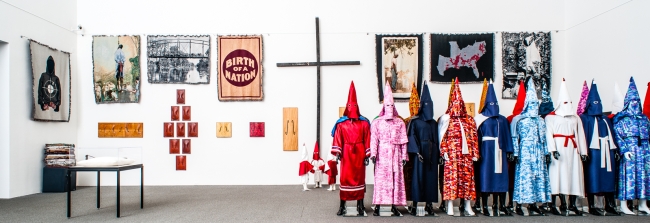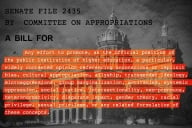You have /5 articles left.
Sign up for a free account or log in.

Earlier installation of exhibit now at York College
Photo by Ryan Stevenson
This article contains explicit and potentially offensive terms that are essential to reporting on this situation.
On York College of Pennsylvania's website, information about the college's art galleries describes programming at the college as "free and open to the public."
For an exhibit wrapping up, however, the public is not invited. In an unusual move for a college museum (or museums generally) York has restricted attendance to those who are students, faculty and staff members of the college, and selected invited guests. The public hasn't been invited.
Pamela Gunter-Smith, the president of York, said in an interview Monday that she learned about the race-focused exhibit only a week before it was to open -- shortly after the violence that accompanied the August march of white supremacists in Charlottesville, Va. She said that the decision to go ahead with the exhibit, but close it to the general public, was for her “as a woman of color, a damned if you do, damned if you don’t” decision.
The exhibit, “Rewind,” is by Paul Rucker, a Baltimore artist whose work focuses on the racism he sees as a black man in society and history. The exhibit features a mix of artistic creations, such as a series based on Ku Klux Klan robes, but in colors and patterns that will surprise those expecting white only. There are also images of lynchings and artifacts, such as a branding iron used on runaway slaves who were captured. Some of the artifacts include the use of racist language, such as a cartoon from 1860 called "The Nigger and the Tiger."
Anyone reading the background material would know that the exhibit is intended to remind people about racism, and to condemn racism. And the college has organized a series of lectures and events to provide what Gunter-Smith calls "the context" for the art.
She added that the exhibit "is very provocative, and elicits very strong emotions." She said she was confident that the college could provide the necessary guidance and information to its students. But she wasn't sure that would be the case with members of the public.
Had Charlottesville not happened, Gunter-Smith said, she might not have had the same concerns she did when "Rewind" was about to open. "When the exhibit came to us, it was not a usual time."
And Gunter-Smith added that, in weighing options, "my No. 1 concern and obligation is to the students and this campus and the learning environment."
Hunter O'Hanian, executive director of the College Art Association, said via email that York's handling of the situation left him with questions.
"It’s curious why an educational institution would mount an exhibition that can only be seen by those with valid IDs and their guests," he said. "It seems they do not believe that the general public is capable of seeing the work and understanding the context in which it is presented. I’m not sure what information they have that leads them to believe their student body has more ability in handling the work than the general public. One also wonders what steps they have taken to provide the proper context for the work, if needed. It just doesn’t seem to make sense."
Rucker, the artist, said via email that he was pleased with the student response to the art and disappointed that the college had limited access to his work.
"The students at York have been amazing and supportive. They've come to the show and special events in large numbers," he said. "The frustration I have with the institution is deeply rooted in the missed opportunity, and the 'concern for safety' rooted in fear."
He said his art isn't designed to make people comfortable. "I do this work for the sake of dialogue and discussion. I'm not a commercial artist," he said.








